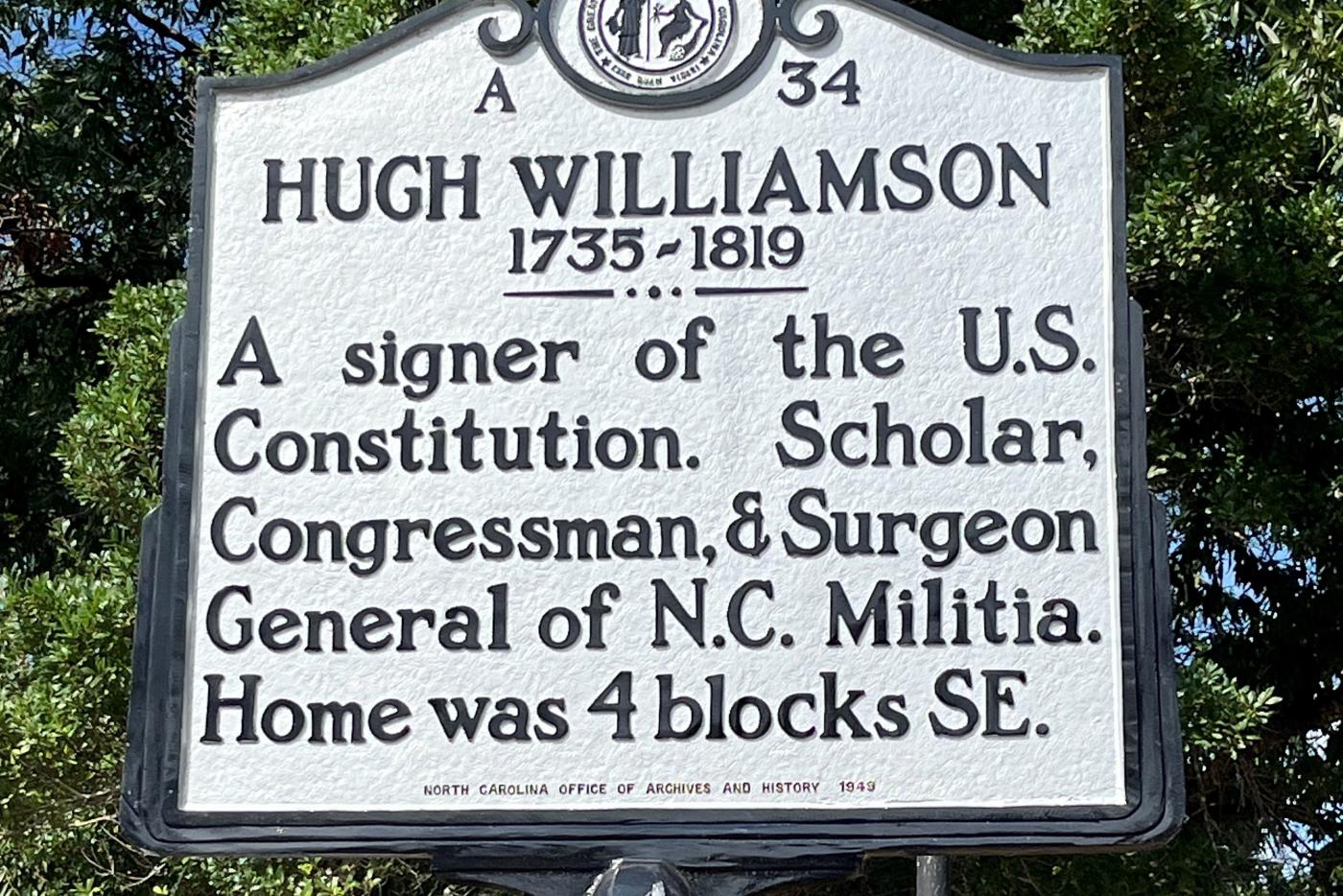Location: US 17 Business (North Broad Street) in Edenton
County: Chowan
Original Date Cast: 1949
Hugh Williamson, signer of the United States Constitution, was born on December 5, 1735, in Chester County, Pennsylvania, the son of John W. and Mary Davison Williamson. Williamson received a good education, first attending several private academies and then entering the College of Philadelphia (later known as the University of Pennsylvania) where he graduated in 1757.
After graduation, Williamson decided to become a Presbyterian minister, but his disaffection with the infighting between “Old Light” and “New Light” Presbyterians resulted in his forsaking a theological career. Instead, he reentered the College of Philadelphia in 1760 to study medicine. Three years later, Williamson resigned a teaching position he had accepted while pursuing his degree and sailed for Scotland. He resumed studying with various medical professionals in Edinburgh, London, and Utrecht in the Netherlands, where he eventually received his medical degree.
Upon his return to Philadelphia in 1768, Williamson was elected a member of the American Philosophical Society, one of the premier social and intellectual clubs in North America. He opened a medical practice in Philadelphia, but also tinkered with astronomy and natural sciences. In 1770 his “Observations on Climate” and a paper concerning electric eels won him special recognition by the Royal Society in London and the University of Leyden awarded him an honorary doctorate of humanities.
In 1773, while en route to England in a funding effort for Newark Academy, Williamson’s vessel stopped in Boston. While there, he personally witnessed the turmoil caused by the Stamp Act and was present during the aftermath of the Boston Tea Party. He sailed for London on the Hayley, a vessel owned by Patriot leader John Hancock. Brought before the British Privy Council, Williamson relayed the news of the event and impressed upon that them that, if the government did not alter its course, civil war or revolution was imminent. He also wrote a letter to Lord Mansfield, Britain’s chief justice, entitled a “Plea for the Colonies” and was one of twenty-nine Americans in London who signed a petition addressed to Parliament protesting the Port Bill.
Williamson remained in Britain until late 1776, where as a result of his scientific interests, he became close friends with Benjamin Franklin. Legend states that, upon the news of the Declaration of Independence, Williamson sailed for home, but was captured enroute by a British vessel. He supposedly managed to escape in a small boat, and subsequently offered his services to the Continental Army but was turned down due to a lack of vacancies for surgeons. Unfortunately, no documentary record of these events exists.
What is certain is that, by summer 1777, Williamson was in Charleston, South Carolina, entered a mercantile business with his brother John. Later that year, while enroute to Baltimore, Williamson stopped in Edenton. His further progress northward impeded by the British army, Williamson chose to settle in Edenton, opening a shipping business, a tannery, and a medical office. Shortly afterwards he volunteered his services to Governor Richard Caswell and began vaccinating North Carolina Continental troops for smallpox. He soon was appointed surgeon general of all North Carolina militia. He served in that capacity at the Battle of Camden in August 1780, and then with General Isaac Gregory in the Great Dismal Swamp area during the 1781 campaigns.
Elected to the North Carolina House of Commons from Edenton in April 1782, Williamson embarked on a political career. He was appointed to the Continental Congress shortly thereafter, in which he served for the next three years. He was present in December 1783 when George Washington resigned as commander-in-chief of the Continental Army and is represented in Charles Wilson Peale’s painting of the event. Afterwards he returned to Edenton, was reelected to the House of Commons, and wrote the state’s first copyright law, “Security for Literary Property.”
In 1786 Williamson attended the Annapolis Convention and, the following year, attended the Constitutional Convention in Philadelphia as part of the North Carolina delegation along with William Blount and Richard Dobbs Spaight. A strong Federalist, Williamson worked hard for the ratification of the Constitution, attending the Second Constitutional Convention in Fayetteville in 1789 as a delegate from Tyrrell County. He served in the First and Second United States Congresses, and remained a strong Federalist, although he opposed the assumption of state debts on the grounds that it would be unfair to states such as North Carolina who had already paid most of their debts.
On January 3, 1789, Williamson married Maria Apthorpe, the daughter of a wealthy New York merchant and former Loyalist. She died in October 1790 after the birth of their second son. After his wife’s death, Williamson retired from public service, and settled with his wife’s family in New York City. Devoting himself to writing and philanthropy he became one of the original trustees of the University of North Carolina and wrote A History of North Carolina, the first post-Revolutionary history of the state. He died on May 22, 1819, and was buried in his wife’s family tomb in Trinity Cemetery in New York City.
References:
William S. Powell, ed., Dictionary of North Carolina Biography, VI (1996), 217-218—sketch by John L. Humber
Louis W. Potts, “Hugh Williamson: The Poor Man’s Franklin and the National Domain,” North Carolina Historical Review (October 1987): 371-393
Don Higginbotham, ed., Papers of James Iredell, II (1976)
Alice B. Keith, ed., John Gray Blount Papers, II (1959)
Samuel A. Ashe, ed., Biographical History of North Carolina, V (1906)
Hugh Williamson Papers, North Carolina State Archives, Raleigh

